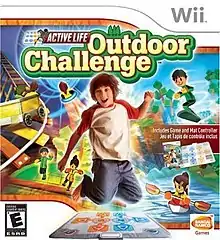Active Life: Outdoor Challenge
Active Life: Outdoor Challenge (Family Trainer: Athletic World in Japan and Family Trainer in Europe) is a 2008 video game for the Wii produced by Bandai Namco Games. Players use a mat similar to the Power Pad in conjunction with the Wii Remote in order to complete a variety of mini-games. The game is comparable to Wii Fit. As of January 30, 2009, the game has sold one million copies worldwide.[2] A sequel, titled Active Life: Extreme Challenge, was released on August 11, 2009.
| Active Life: Outdoor Challenge | |
|---|---|
 Original North American Wii box art | |
| Developer(s) | h.a.n.d.[1] |
| Publisher(s) | Bandai Namco Games |
| Director(s) | Yoshihiro Tamura |
| Designer(s) | Atsuko Higashiyama Wataru Nakamura Miku Kamikawa Keiko Ueda Nobuo Yamashita Kazushi Kōsaka |
| Composer(s) | Kenjiro Hiwatari Makoto Igarashi Yuki Watanabe Atsuko Kawanishi |
| Platform(s) | Wii, Nintendo Switch |
| Release | Wii Nintendo Switch |
| Mode(s) | Single player, multiplayer |
An enhanced port of the game was released for the Nintendo Switch in December 2020 in Japan, and in September 2021 in North America, Europe, and Oceania. Physical copies the Nintendo Switch port are bundled with two leg-strap accessories, which are required for co-op gameplay.
Gameplay
Active Life: Outdoor Challenge is a fitness game controlled by a mat on the floor that responds to hand or feet movement on specific areas on the mat. The game has multiple control styles, which vary depending on the game. The mat used to control the game has a total of 10 buttons, each with different purposes. In the middle of the mat, there are 2 square buttons, one orange and one blue. These buttons are used in most games for basic movement such as jumping or running. There are 6 arrows surrounding every side of the mat, 3 orange and 3 blue. These buttons are mostly used for directional movement in single player, and for running in the two player games. The mat also features a plus and minus button on either side of the mat. The buttons essentially act as a way to help navigate menus without having to pick up the controller, as well as to pause the game. As the Mat Controller connects to the console directly through GameCube controller ports, the controller and game are incompatible with subsequent Wii models that do not have them. The Nintendo Switch port replaces the Mat Controller with leg straps that the player wears, each containing a separated unique Joy-Con to control movement, and its reliance on separated Joy-Con renders the game incompatible with the one-piece Nintendo Switch Lite.[3]
The game features many minigames and three main modes, and can be played alone or head-to-head with a second player.
Reception
| Aggregator | Score |
|---|---|
| Metacritic | 69/100[4] |
| Publication | Score |
|---|---|
| GameZone | 5/10[5] |
| Nintendo World Report | 7/10[6] |
The game received mixed reviews from critics, receiving a 69 out of 100 from Metacritic.[4] Louis Bedigian on Gamezone gave it a 5 out of 10, stating that "while the game is successful in some areas and downright creative in others, Active Life: Outdoor Challenge is not be the most entertaining or most beneficial way to get in shape."[5] Nintendo World Report reviewed the game, saying that the game "is a very promising start to a series and a great complement to Wii Fit."[6]
References
- "h.a.n.d. work history". Archived from the original on 2009-09-30.
- Dimola, Nick (2009-01-29). "Namco's Family Trainer Sells Over a Million". Nintendo World Report. Archived from the original on 1 February 2009. Retrieved 2009-01-30.
- "Active Life: Outdoor Challenge (Nintendo Switch)". Bandai Namco Entertainment. Bandai Namco Entertainment. Retrieved 26 October 2021.
- "Active Life: Outdoor Challenge". Metacritic. Retrieved December 9, 2018.
- Ronaghan, Louis. "Active Life: Outdoor Challenge Review". Gamezone. Archived from the original on January 26, 2010. Retrieved December 9, 2018.
- Bedigian, Neal. "Active Life: Outdoor Challenge". Nintendo World Report. Retrieved December 9, 2018.
- Boyes, Emma (2007-09-19). "TGS '07: Namco Bandai embraces Active Life". GameSpot. Archived from the original on 26 October 2007. Retrieved 2007-11-27.